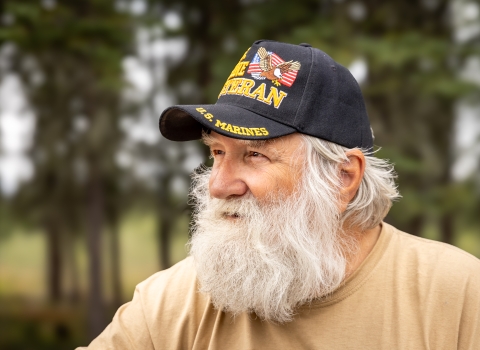Do you remember your first, outdoor experiences when you were young?
Maybe it was watching a flitting butterfly, looking up at the night sky and counting stars, digging holes and planting seeds in a garden, collecting rocks, catching a fish, or hearing a bird’s song during a school nature walk.
Some of my first memories of nature as a girl were going for walks in the woods with my mom, smelling fresh cut alfalfa or fresh rain, running barefoot on mossy paths in the Adirondacks with mud squishing between my toes, catching newts, fishing with my mom…
There are so many ways that a love of the outdoors can become instilled into our very being, at every age. It’s different for everyone and that’s what makes it our nature. My sense is that this love of nature binds us at the Service – we get it.
And this month is all about inspiring and inviting others to connect to nature, advancing environmental learning and awareness and a growing stewardship ethic, especially for young people.
Last week, the Service pledged to help students become tomorrow’s conservation professionals by signing a groundbreaking Memorandum of Understanding with New Mexico State University and the University of Texas-San Antonio as part of a new partnership to bring diverse students into the conservation community and into careers with the Fish and Wildlife Service.
Earth Day
And now we’re counting down to Earth Day on Friday, April 22, 2022!
Earth Day marks the anniversary of the movement in 1970 to raise environmental awareness. It’s a time when people around the world pitch in to pick up litter, plant trees…and do what we can to reduce the harm from climate change climate change
Climate change includes both global warming driven by human-induced emissions of greenhouse gases and the resulting large-scale shifts in weather patterns. Though there have been previous periods of climatic change, since the mid-20th century humans have had an unprecedented impact on Earth's climate system and caused change on a global scale.
Learn more about climate change and pollution. It’s a time when we work together to make our world a healthier place to live.
Earth Day is also a time to renew our commitment to youth and ensure we are engaging and employing those who will inherit the future. Today’s young adults are finely attuned to the climate crisis and the monumental challenges that are before us and in store for them to provide a sustainable future for wildlife and people.
For the Service, our Earth Day focus on young people and the environment is timely and inspiring.
Bringing the Next Generation to Nature
We are making real strides in welcoming the next generation to nature and the Service through three, interconnected program areas – education, recreation, and employment – and their related activities, which are closely aligned with our Justice, Equity, Diversity, Inclusion, Accessibility (JEDIA) goals and our urban and climate initiatives.
Education Programs & Opportunities that work with teachers and students of all ages toadvance academic achievement and wildlife conservation literacy.
The Service is building an impressive library of curricula for grades K-12 that provide outdoor experiences while building cognitive skills. This work is complementary to the many partnerships that our National Wildlife Refuges, National Fish Hatcheries, field stations, and other Service locations have with schools in their communities to bring conservation into the classroom virtually, in-class, and through field-based programs.
Recreation Programs that connect people’s lives to the natural world around them through outdoor activities that depend on thriving wildlife populations.
The last two years have shown us that people are looking for fun ways to be outside together. We’rehelping youth gain outdoor recreation skills in areas like photography, paddling, fishing, and archery. We’re also creating outdoor skills centers in under-served communities like those at our 101 urban national wildlife refuges and urban partnerships.
Employment programs that open new paths to conservation internships and jobs, ensuring that tomorrow’s leaders are ready to confront a myriad of wildlife conservation challenges.
The Service partners with more than 100 organizations that provide internships, fellowships, and job training and offer a path to government careers. Here, too, we are prioritizing partnerships that work with under-served groups, expand career opportunities, and strengthen communities, like our partnerships with the Hispanic Access Foundation (HAF), Groundwork USA, American Conservation Experience (ACE), American Indian for Higher Education Consortium, and the Thurgood Marshall College Fund.
Last year, Service programs contributed more than $17 million to projects that led to the placement of more than 800 interns.
From National Wildlife Refuge System Headquarters, we invested $4 million to increase job opportunities through the Youth Conservation Corps (YCC), partner-based internships, and student employment programs. We invested an additional $2 million from CARES Act funding with YCC network partners to provide needed visitor services assistance.
Through HAF’s MANO Project Initiative, we’re engaging young people in diverse communities to be at the front and center of helping us combat the climate crisis. With the MANO Project, we launched an 18-month fellowship program for the newly reintroduced Civilian Climate Corp (CCC) program at the National Wildlife Refuge System. A cohort of six CCC fellows came on board in January and are helping to test a prototype “rapid assessment” planning framework for integrating climate adaptation into management plans. Thanks for joining us!
You can find some fantastic content about celebrating Earth Day with the Service on our website.
Happy Earth Day! Here’s to a bright future of conservation stewardship.
--Martha



